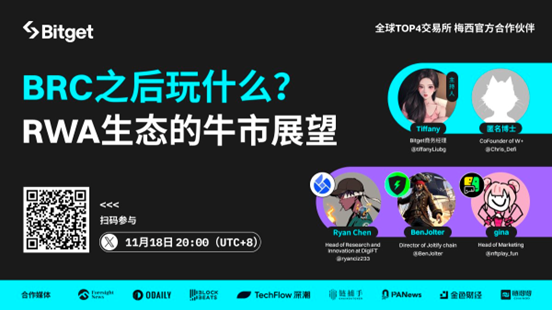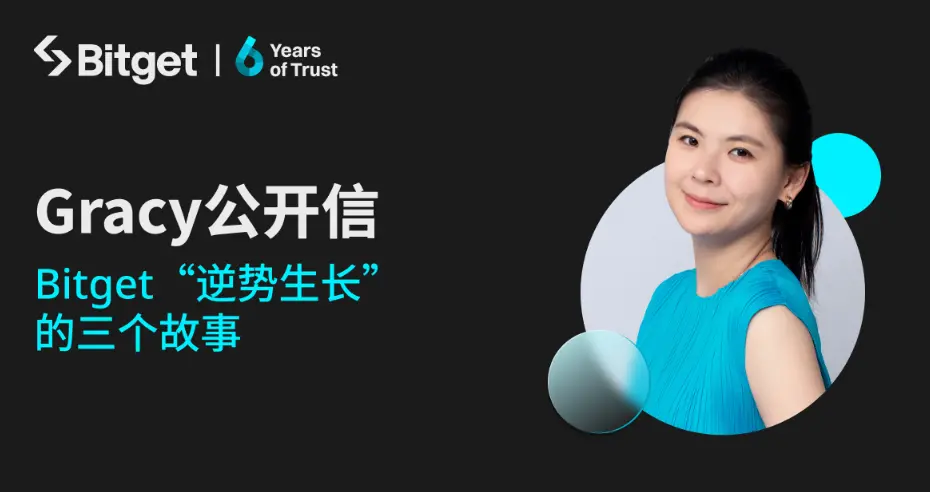Bitget AMA Transcript: What to Play After BRC? Bull Market Outlook for the RWA Ecosystem
Author: Bitget
Recently, Bitget held an X Space in its Chinese community themed "What to Play After BRC? A Bull Market Outlook for the RWA Ecosystem," to discuss the next potential hotspot in the crypto industry—the RWA track. The participating guests included: Dr. Anonymous (CoFounder of W), Ryan Chen (Head of Research and Innovation at DigiFT), BenJolter (Director of Joltify chain), and NFT Play_gina (Head of Marketing).

The following is a transcript of the community dialogue:
Host:
The first question is: When did you first come into contact with the RWA track? Do you think RWA can become the optimal solution for connecting real-world assets and crypto-world assets?
gina:
I officially came into contact with RWA around June of this year. But in fact, RWA cannot be said to be a new concept or something new. In my view, it returns to the original intention of blockchain technology, which was born to solve this problem. Now, the attention to this direction is a very good trend and a signal for the healthy development of this industry.
Ryan:
From my understanding, RWA refers to assets issued in the form of tokens, but they correspond to underlying assets from the real world. In other words, the rights or businesses corresponding to this token come from the real world, so this type of asset can be classified as RWA. Therefore, it can be said that the earliest RWA is the stablecoins we are familiar with that are backed by real assets.
Ben: RWA is crucial for the future development of blockchain. If blockchain is limited to niche assets like games, NFTs, etc., it will be difficult to grow. Only by bringing real-life assets onto the blockchain can we potentially expand blockchain. However, there are two important points to bring real assets onto the blockchain: first, compliance; second, the underlying assets must be of high quality.
Host:
The second question is, after the popularity of BRC 20, everyone feels that the bull market has returned. In the next bull market, what role do you think RWA will play? Will it lead the development of the bull market?
gina:
BRC 20 has recently become very popular, giving everyone a new hope. As for RWA, I do not believe it can lead the entire bull market; I believe it can expand the Web 3 market and attract more traditional institutions and ordinary users into the Web 3 space. Therefore, I think in the next stage, RWA may bring more traffic and value to the entire blockchain and Web 3.
Ryan:
From my perspective, RWA is more like a channel that transfers traditional high-quality assets onto the chain through a series of complex financial supply chains, tools, etc. A bull market needs to open up channels to allow funds to flow in and out easily, so it may serve as an infrastructure to kickstart the bull market.
Ben:
I believe RWA is not just the main narrative of the next bull market but also a bridge that can bring blockchain into mainstream finance afterward. It will not only bring a bull market but will also open up an eternal bull market. This is our understanding, and we have this belief about it.
Host:
The third question is, in the RWA track, what do you think are the necessary factors for a project to break out?
gina:
Currently, everyone in the RWA track is still experimenting and thinking about how to do it better. In my view, RWA products should start from solving the pain points and drawbacks of traditional finance. If these two aspects can be addressed, the product is likely to be welcomed by users.
Ryan:
For RWA to break out, it needs to effectively address compliance and licensing issues. For example, in major financial cities like Singapore, Hong Kong, and even the United States, many businesses are difficult to operate without a license. So I believe compliance and licensing will definitely be a focus.
Ben:
Indeed, I resonate with this; compliance is the primary prerequisite. Additionally, how to bring quality assets to the world, especially to some developing countries where people have money but cannot find such quality assets, an efficient and inexpensive channel would be very valuable for them, which is one of the advantages of blockchain.
Host:
The fourth question is, what challenges does RWA face during its digitization process, and what issues need urgent resolution? How can builders address these issues?
gina:
I personally believe the key issue for RWA is the real-time mapping of on-chain assets and physical assets. Additionally, the income from RWA assets, which is operational cash flow, and how traditional financial assets can be tokenized and combined with blockchain technology to create new play methods.
Ryan:
What we urgently need to solve is the issue of token asset confirmation. Especially when combined with DeFi play methods, how should the ownership of these underlying assets be realized? So token confirmation may be a significant issue.
Ben:
Currently, the biggest problem in the RWA track is still compliance. Everyone must respect the law and compliance; only by fully respecting these can it truly grow, that’s my thought.
Host:
The fifth question is, some users are very optimistic about the RWA track. Can you give some advice to new users? For example, which projects in this track can be tried and experienced?
gina:
New users can try to invest in some tokenized assets with lower entry barriers, including some cross-regional products or artworks, etc. In terms of risk, they need to check if there have been any defaults, understand their insurance underwriting due diligence processes, and also consider some regular management risks, etc.
Ryan:
Currently, there are two major areas in RWA: one is stablecoins, and the other is fixed-income products. The yields on fixed-income products are not that attractive, mainly focusing on U.S. Treasury bonds, and due to compliance restrictions, most fixed-income products are currently only available to institutional users. If some new users are interested, they can consider some RWA-related projects, such as Maker Dao's Spark Protocol, etc.
Ben:
RWA is essentially about bringing financial assets and resources from the physical world onto the blockchain, allowing the convenience and speed of blockchain to save capital. Therefore, everyone can look more into how finance operates in the physical world, which financial capital is the best, safest, and offers the highest returns, and then find such assets on the chain. I think that is a good direction.
In addition to the intense discussions and exchanges among the guests, enthusiastic audience members also joined the discussion. Here are some questions that users were concerned about:
Enthusiastic Audience Member 1: As an ordinary investor, what is the role of participation in RWA, and how can ordinary investors enjoy the benefits brought by RWA?
Ben:
There are actually two ways to share in the success of RWA. The first is to find good targets on-chain, such as U.S. Treasury bonds, real estate funds, and some good companies. The second is to find a good RWA project that ties profits and dividends to the tokens held. On one hand, it is the success of the project itself, and on the other hand, it is the success of the token.










